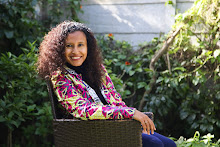Being Brown in Lebanon
Pita log 5
Tripoli, North Lebanon
A few things I have learnt about men, women and being brown (since my last post):
1. Women here get their nails done every week. Preferably in bright red.
2. Women who are NOT domestics wear long black coats (leather or wool) and shiny black boots. Domestics (mostly from India, Senegal and Nepal) where jeans, sneakers and stare at me (wondering why I am an Indian wearing a black coat with sneakers).
3. Cafes are male domain. But strange looking brown women (aka me) will be served with a smile when they wear a black coat, have red painted nails and say “Ana ma beHki Arabi. Ana beHki Ingleezi” (I don’t speak Arabic. I only speak English) flirtatiously. And yes, in case you were wondering, I DO have red painted nails now :)
4. You are nuts if you don’t smoke. Going to a bar or café = getting smoke blown into your hair, clothes, face, eyes. So don’t complain. Don’t be a passive smoker. Be an active one.
5. Dating call on the corniche is honk honk, gawk gawk. Alternatively it’s honk honk, smoochie smooch noise and what’s your number? At which point if you are not interested you yell “Aayb” (Shame on you) or “Imshee” (Go away). But don’t get confused like me and yell Kimchee by mistake. If all else fails flash your wedding ring.
6. You might not see too many lone women walking around on the corniche. But suddenly out of nowhere they’ll be one in a hijab jogging and she will restore your faith in womankind.
7. You are ‘Afreekan’ if you have curly hair and are not very fair.
8. Everyone in Tripoli/Mina is everyone’s cousin.
9. You are both hated and loved if you say you are from America.
10. You are either a domestic (F) or in the Indian Army (M) if you look brown enough.
11. There are no addresses in Lebanon.
12. Atimaj Bachhhan and Raj Kupoor rule. Watch Zee Arabia and the Sheikh become a Bollywood star for proof.
PS: My list of Arabic words and phrases is increasing, shway by shway!
I now know how to write and speak numbers one to ten.
Say hello, How are you, Welcome, Pleased to meet you, Thank you, Pardon, Sorry, Just a minute, good morning, good evening (good night is too hard).
How much is that, Can you please write that down, I am from the U.S (or India as the situation seems to demand), I don’t understand, I understand, I speak English, I don’t speak French, I don’t speak Arabic.
And of course the already mentioned phrases required to ward off men and get served coffee.
Tripoli, North Lebanon
A few things I have learnt about men, women and being brown (since my last post):
1. Women here get their nails done every week. Preferably in bright red.
2. Women who are NOT domestics wear long black coats (leather or wool) and shiny black boots. Domestics (mostly from India, Senegal and Nepal) where jeans, sneakers and stare at me (wondering why I am an Indian wearing a black coat with sneakers).
3. Cafes are male domain. But strange looking brown women (aka me) will be served with a smile when they wear a black coat, have red painted nails and say “Ana ma beHki Arabi. Ana beHki Ingleezi” (I don’t speak Arabic. I only speak English) flirtatiously. And yes, in case you were wondering, I DO have red painted nails now :)
4. You are nuts if you don’t smoke. Going to a bar or café = getting smoke blown into your hair, clothes, face, eyes. So don’t complain. Don’t be a passive smoker. Be an active one.
5. Dating call on the corniche is honk honk, gawk gawk. Alternatively it’s honk honk, smoochie smooch noise and what’s your number? At which point if you are not interested you yell “Aayb” (Shame on you) or “Imshee” (Go away). But don’t get confused like me and yell Kimchee by mistake. If all else fails flash your wedding ring.
6. You might not see too many lone women walking around on the corniche. But suddenly out of nowhere they’ll be one in a hijab jogging and she will restore your faith in womankind.
7. You are ‘Afreekan’ if you have curly hair and are not very fair.
8. Everyone in Tripoli/Mina is everyone’s cousin.
9. You are both hated and loved if you say you are from America.
10. You are either a domestic (F) or in the Indian Army (M) if you look brown enough.
11. There are no addresses in Lebanon.
12. Atimaj Bachhhan and Raj Kupoor rule. Watch Zee Arabia and the Sheikh become a Bollywood star for proof.
PS: My list of Arabic words and phrases is increasing, shway by shway!
I now know how to write and speak numbers one to ten.
Say hello, How are you, Welcome, Pleased to meet you, Thank you, Pardon, Sorry, Just a minute, good morning, good evening (good night is too hard).
How much is that, Can you please write that down, I am from the U.S (or India as the situation seems to demand), I don’t understand, I understand, I speak English, I don’t speak French, I don’t speak Arabic.
And of course the already mentioned phrases required to ward off men and get served coffee.



